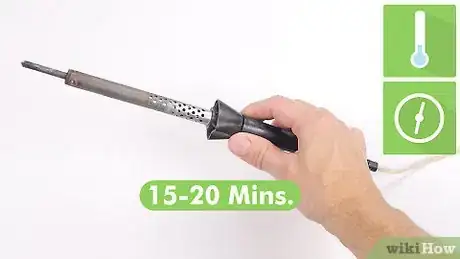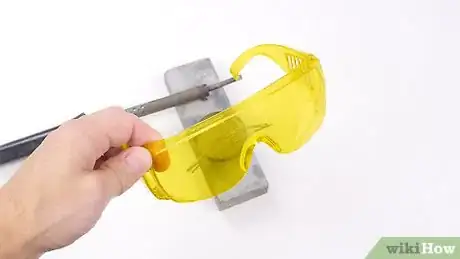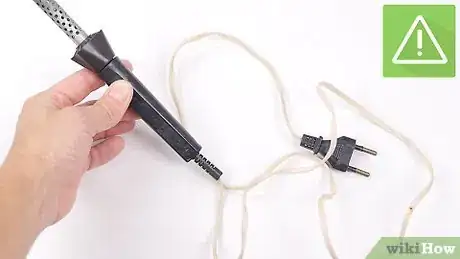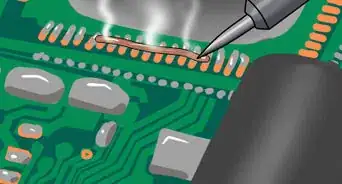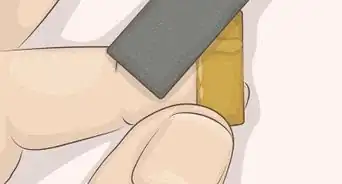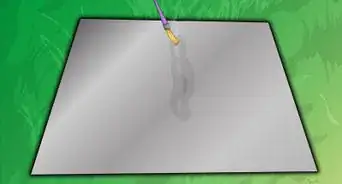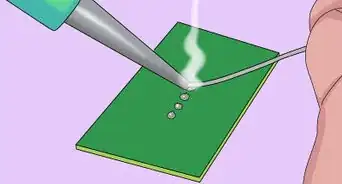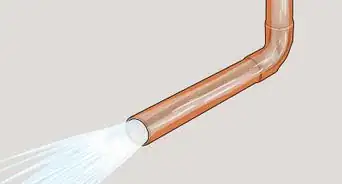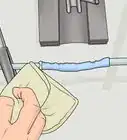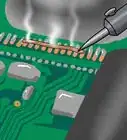This article was co-authored by wikiHow Staff. Our trained team of editors and researchers validate articles for accuracy and comprehensiveness. wikiHow's Content Management Team carefully monitors the work from our editorial staff to ensure that each article is backed by trusted research and meets our high quality standards.
There are 8 references cited in this article, which can be found at the bottom of the page.
The wikiHow Video Team also followed the article's instructions and verified that they work.
This article has been viewed 93,143 times.
Learn more...
If you have a solder iron and want to keep it in good shape, you'll want to clean it regularly. Because the iron tips come into contact with hot metals, they are vulnerable to corroding or rusting. But as long as you thoroughly clean and tin the tip, you'll be able to prevent metal buildup and tip damage over time. Using the right cleaning methods regularly on your solder iron will help you maintain your iron's condition for years.
Steps
Cleaning the Tip
-
1Let the iron cool before cleaning it. Turn off your solder iron and let it cool down for 15-20 minutes before cleaning the tip. This will allow you to clean the device as thoroughly as possible without risking burns.[1]
- Clean the tip immediately after the solder iron to limit buildup over time. Place a sticky note near your workspace if you find yourself forgetting often to make cleaning the iron a priority.
-
2Wipe the iron off with a damp, cellulose and sulfur-free sponge. Take a wet sponge and rub it over the top of the solder iron. Doing this first will take care of any mild buildup and help you discern in a safe way whether the tip is still too warm to touch with bare hands.[2]
- Use sulfur-free sponges made specifically for soldering, as regular sponges will not remove the solder as efficiently.
Advertisement -
3Use dampened steel wool to get rid of surface stains or rust. If you do not regularly clean your solder iron, you may have more stubborn stains or discoloration. Take a steel wool pad and dampen it slightly, then scrub it over the iron's tip to remove rust and any other heavy staining.[3]
- Steel wool is the only cleaning item safe to remove rust or stains with. Avoid sandpaper, which is too corrosive for solder iron tips.[4]
Tinning the Iron
-
1Wear eye protection while tinning the tip. After cleaning the tip, it is advised that you coat the tip in a thin, even layer of solder. This is called "tinning," and it helps protect the tip from rust or oxidization. That being said, many chemicals in solder are eye irritants. Solder has a tendency to "spit," or pop if you accidentally hit an air pocket, so keep safety goggles on at all times.[5]
- Tin the solder iron after every use to prevent rusting.
- Make sure to wear eye protection at all times while using a hot solder iron.
- Although gloves are not required for tinning, it is suggested that you wash your hands with soap and water afterward.[6]
-
2
-
3Keep the solder in place with an alloy cleaner. After turning the solder iron off and letting it cool, apply a small layer of alloy cleaner over the tip with a microfiber cloth. This will prevent dust buildup over the solder and further diminish the chances of oxidization.[8]
Maintaining a Solder Iron
-
1Use high-quality solder. Although using cheap solder may seem cost-effective in the short term, it can cause damage over time. Impurities in your solder can cause buildup on the tip and inhibit its heat-transferring abilities.
- 60/40 or 50/50 solder is ideal, with the top number representing what percentage of tin is in the solder.[9]
-
2Remove debris buildup after every use. After soldering an item, turn the solder iron off and wait for it to cool. Then, remove the tip and tap the barrel to dislodge any debris. This will prevent buildup from clogging your solder iron over time and diminishing its efficiency.
-
3Check the solder iron's cord for burns or cracks. A solder iron's cord is prone to damage because of the high heat the device is used under. If you notice any cord damage, hire a professional electrician to replace the cord.
- Solder irons with cord damage are not only inefficient but also dangerous to work with.
-
4Wipe off the iron's tip between strokes. Cleaning the solder iron's tip while it is in use will result in better soldering work. Wipe a wet sponge across the solder iron's tip after each stroke to avoid buildup on the tip.[10]
- When you're finished with your soldering job, you will have less to clean from the tip if you wipe the iron periodically while using it.
Community Q&A
-
QuestionWhy does my soldering iron’s tip turn black?
 wikiHow Staff EditorThis answer was written by one of our trained team of researchers who validated it for accuracy and comprehensiveness.
wikiHow Staff EditorThis answer was written by one of our trained team of researchers who validated it for accuracy and comprehensiveness.
Staff Answer wikiHow Staff EditorStaff AnswerThis happens when the iron on the tip reacts with oxygen at high temperatures. You can prevent this by tinning the tip of your iron. If there’s a lot of sooty buildup on the tip, carefully clean it with an abrasive tip cleaner (which you can get from a hardware or home goods store), then re-tin the cleaned tip.
wikiHow Staff EditorStaff AnswerThis happens when the iron on the tip reacts with oxygen at high temperatures. You can prevent this by tinning the tip of your iron. If there’s a lot of sooty buildup on the tip, carefully clean it with an abrasive tip cleaner (which you can get from a hardware or home goods store), then re-tin the cleaned tip. -
QuestionHow do you remove rust from a soldering iron?
 wikiHow Staff EditorThis answer was written by one of our trained team of researchers who validated it for accuracy and comprehensiveness.
wikiHow Staff EditorThis answer was written by one of our trained team of researchers who validated it for accuracy and comprehensiveness.
Staff Answer wikiHow Staff EditorStaff AnswerActivate the flux of the solder by heating the iron to 482° F-572° F (250° C-300° C), then clean the tip with brass will or an automatic tip cleaner. For more stubborn rust, you may need to use a tip tinner.
wikiHow Staff EditorStaff AnswerActivate the flux of the solder by heating the iron to 482° F-572° F (250° C-300° C), then clean the tip with brass will or an automatic tip cleaner. For more stubborn rust, you may need to use a tip tinner. -
QuestionCan you use steel wool to clean a soldering iron?
 wikiHow Staff EditorThis answer was written by one of our trained team of researchers who validated it for accuracy and comprehensiveness.
wikiHow Staff EditorThis answer was written by one of our trained team of researchers who validated it for accuracy and comprehensiveness.
Staff Answer wikiHow Staff EditorStaff AnswerYes, but keep in mind that steel wool is very hard and can potentially damage your tip. For gentler cleaning, look for a brass wool soldering iron tip cleaner.
wikiHow Staff EditorStaff AnswerYes, but keep in mind that steel wool is very hard and can potentially damage your tip. For gentler cleaning, look for a brass wool soldering iron tip cleaner.
Warnings
- Use and clean solder irons in a well-ventilated area. If you feel dizzy, lightheaded, or nauseated at any time, exit the room immediately and call Poison Control for further instruction.[11]⧼thumbs_response⧽
- Always wash your hands after soldering or cleaning a solder iron. Some materials in solder, like lead, can be toxic if absorbed by the skin or ingested.[12]⧼thumbs_response⧽
Things You'll Need
- Solder
- Microfiber cloth
- Sulfur-free sponge
- Steel wool
- Alloy cleaner
References
- ↑ http://www.esicotriton.com/instructions/tipinstructions.pdf
- ↑ http://www.newark.com/pdfs/techarticles/plato/SolderingIronTipsCare.pdf
- ↑ https://www.youtube.com/watch?v=ijNXNFVNRBY
- ↑ https://www.circuitspecialists.com/blog/soldering-station-maintenance/
- ↑ http://www.newark.com/pdfs/techarticles/plato/SolderingIronTipsCare.pdf
- ↑ http://prototyping.ucsd.edu/docs/soldering_guidelines.pdf
- ↑ https://www.mouser.com/pdfdocs/TechspraySolderTips.pdf
- ↑ https://cdn-shop.adafruit.com/datasheets/hakkotips.pdf
- ↑ https://www.circuitspecialists.com/blog/soldering-station-maintenance/
About This Article
It’s important to clean your solder iron regularly to avoid corrosion and rust. Before you begin, make sure that the solder iron is completely cool so that you don’t burn yourself. First, wipe the tip of the iron with a damp, cellulose and sulfur-free sponge to get rid of any buildup. Then, use damp steel wool to scrub off any rust or other heavy stains. Once the iron is clean, apply a small amount of fresh solder to the tip to tin the iron. This helps to prevent rusting during future use. For more information on cleaning a solder iron, like how to maintain the iron, read on!
